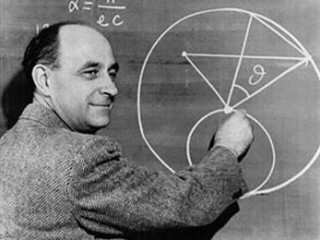
Enrico Fermi biography
Date of birth : 1901-09-29
Date of death : 1954-11-28
Birthplace : Rome, Italy
Nationality : Italian
Category : Science and Technology
Last modified : 2010-05-07
Credited as : Italian nuclear physicist, Fermium synthetic element, Nobel Prize in Physics
Known to have devised the first nuclear reactor and later discovering elements beyond uranium on the period table of elements, Enrico Fermi was a genius of both theoretical and experimental physics that would win him the Nobel Prize for his work in 1938. It was his modest approach, his articulate and sound theories, and his involvement in the Manhattan Project that would bring him academic and world fame.
Young Enrico loved mathematics and physics even in high school. He knew before he graduated that he would go on to university to delve into his passion even more. After the shocking death of his younger brother, Enrico knew he had to keep what he saw as the fun spirit of physics alive. In Pisa, at the Scuola Superior Normale, Enrico obtained his bachelor’s and doctorate degree. By the age of 25, he was granted a full professorship in Rome, where a theoretical physics program was designed for him. He was also given an entire support staff of professors and graduate students.
While in Rome, he discovered beta decay and came up with what is now called Fermi-Dirac Statistics. By 1938, Fermi and his family traveled to Stockholm, Sweden to receive his Nobel Prize in Physics for finding new radioactive materials. After the presentation and his award speech, he and his family took a boat headed for New York City. Enrico knew that if they returned to Italy, his wife, who was Jewish, and perhaps children would be targeted as fascism was spreading with Nazi fundamentalism. He and his family would never go back to Italy.
In 1939, Fermi collaborated with Einstein to write a letter to President Roosevelt telling him about the Nazi’s plan to build an atomic bomb. At the University of Chicago in 1942, Fermi built the first nuclear reactor with government funding. It was located on a squash court and the moment the energy was held stable went down in history marking the new “Atomic Age”.
Enrico Fermi never wrote his autobiography, but he did publish many more papers in regard to nuclear fission and atomic energy. He always focused on simple mechanisms in an attempt to solve what many others had deemed impossible. For a while, Fermi served on the general advisory committee of the Atomic Energy Commission. He also worked on theories and experiments for particle physics. By his fiftieth birthday, he could have won the Nobel Prize several times over for his contributions. He died at the young age of 53 from stomach cancer in Illinois, in the United States.
















